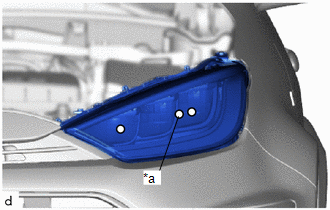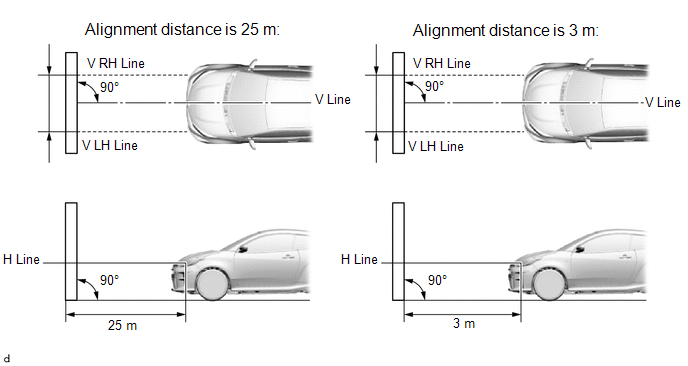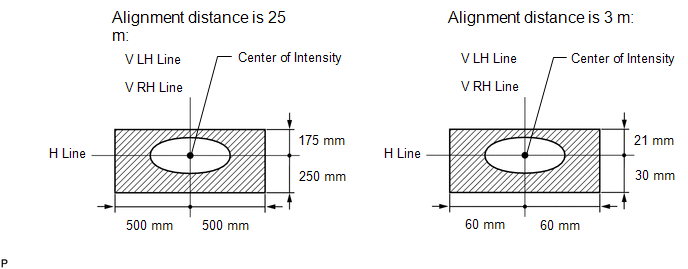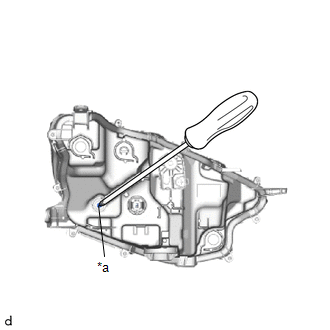Toyota Yaris: Headlight Assembly / Adjustment
ADJUSTMENT
PROCEDURE
1. PREPARE VEHICLE FOR HEADLIGHT AIM ADJUSTMENT
(a) Prepare the vehicle:
- Ensure that the vehicle body is not damaged or deformed around the headlights.
- Fill the fuel tank.
- Make sure that the oil is filled to the specified level.
- Make sure that the engine coolant is filled to the specified level.
- Inflate the tires to the appropriate pressure.
- Unload the trunk and vehicle, ensuring that the spare tire, tools and jack are in their original positions.
- Bounce the vehicle at the corners up and down to stabilize the suspension.
- Sit a person of average weight (75 kg, 165 lb) in the driver's seat.
2. PREPARE FOR HEADLIGHT AIMING (Using a headlight aim test machine)
(a) Adjust the headlight aim in accordance with the headlight aim test machine instructions.
3. PREPARE FOR HEADLIGHT AIMING (Using a screen)
(a) Prepare the vehicle:

- Place the vehicle in a location that is dark enough to clearly observe the cutoff line. The cutoff line is a distinct line, below which light from the headlights can be observed and above which it cannot.
- Place the vehicle at a 90° angle to a wall.
- Create a 25 m (82 ft.) distance between the vehicle (center marks of the headlights) and the wall.
- Make sure that the vehicle is on a level surface.
- Position the front wheels straight ahead.
- Bounce the vehicle up and down to settle the suspension.
NOTICE:
A distance of 25 m (82 ft.) between the vehicle (center marks of the headlights) and the wall is necessary for proper aim adjustment. If sufficient space is not available, secure a distance of exactly 3 m (9.84 ft.) to allow for checking and adjustment of the headlight aim. (The size of the target zone will change with the distance, so follow the instructions in the illustration.)

| *a | Center Mark |
(b) Prepare a piece of thick white paper (approximately 2 m (6.56 ft.) (height) x 4 m (13.1 ft.) (width)) to use as a screen.
(c) Draw a vertical line down the center of the screen (V line).
(d) Set the screen as shown in the illustration:

HINT:
- Stand the screen perpendicular to the ground.
- Align the V line on the screen with the center of the vehicle.
(e) Draw base lines (H, V LH, and V RH lines) on the screen as shown in the illustration.
HINT:
- The base lines differ for "low beam inspection" and "high beam inspection".
- Mark the headlight center marks on the screen.

| *a | Center Mark |
.png)
| *a | V LH Line |
| *b | V Line |
| *c | V RH Line |
| *d | H Line |
| *e | Ground |
(1) H Line (Headlight height):
Draw a horizontal line across the screen so that it passes through the center marks. The H line should be at the same height as the center marks of the headlights.
(2) V LH Line, V RH Line (Center mark position of left-hand (LH) and right-hand (RH) headlights):
Draw 2 vertical lines so that they intersect the H line at each center mark (aligned with the center marks of the headlights).
4. INSPECT HEADLIGHT AIMING
(a) Cover the headlight on the opposite side to prevent light from the headlight that is not being inspected from affecting the headlight aiming inspection.
NOTICE:
Do not keep the headlight covered for more than 3 minutes. The headlight lens is made of synthetic resin, which may melt or be damaged due to excessive heat.
(b) Start the engine.
(c) Turn on the headlights and check if the cutoff line for each low beam matches the preferred cutoff line in the illustration.

HINT:
- Since the low beam headlight and the high beam headlight are a unit, if the aim on the low beam is correct, the high beam should also be correct. However, check both beams to make sure.
-
If the alignment distance is 25 m (82 ft.):
The low beam cutoff line should be between 50 mm (1.97 in.) and 375 mm (1.23 ft.) below the H line as well as 250 mm (9.84 in.) left or right of the V LH or V RH line.
-
If the alignment distance is 3 m (9.84 ft.):
The low beam cutoff line should be between 9.9 mm (0.390 in.) and 45 mm (1.77 in.) below the H line as well as 30 mm (1.18 in.) left or right of the V LH or V RH line.
-
If the alignment distance is 25 m (82 ft.):
The horizontal line of the preferred low beam cutoff line is 250 mm (9.84 in.) below the H line and point A of the preferred low beam cutoff line is on the V LH or V RH line.
-
If the alignment distance is 3 m (9.84 ft.):
The horizontal line of the preferred low beam cutoff line is 30 mm (1.18 in.) below the H line and point A of the preferred low beam cutoff line is on the V LH or V RH line.
(d) Turn on the high beams and check if the center of intensity for each high beam matches the preferred center of the intensity in the illustration.

HINT:
- Since the low beam headlight and the high beam headlight are a unit, if the aim on the low beam is correct, the high beam should also be correct. However, check both beams to make sure.
-
If the alignment distance is 25 m (82 ft.):
The high beam center of intensity should be within 175 mm (6.89 in.) above and 250 mm (9.84 in.) below the H line as well as 500 mm (1.64 ft.) left or right of the V LH or V RH line.
-
If the alignment distance is 3 m (9.84 ft.):
The high beam center of intensity should be within 21 mm (0.827 in.) above and 30 mm (1.18 in.) below the H line as well as 60 mm (2.36 in.) left or right of the V LH or V RH line.
5. ADJUST HEADLIGHT AIMING
(a) Adjust the aim vertically:
| (1) Adjust the aim of each headlight to the specified range by turning each aiming screw (A) with a screwdriver. NOTICE: The final turn of the aiming screw should be made in the clockwise direction. If the screw is tightened excessively, loosen it and then retighten it, so that the final turn of the screw is in the clockwise direction. HINT:
|
|
(b) Adjust the aim horizontally:
| (1) Adjust the aim of each headlight to the specified range by turning each aiming screw (B) with a screwdriver. NOTICE: The final turn of the aiming screw should be made in the clockwise direction. If the screw is tightened excessively, loosen it and then retighten it, so that the final turn of the screw is in the clockwise direction. HINT:
|
|
 Disassembly
Disassembly
DISASSEMBLY CAUTION / NOTICE / HINT NOTICE:
Be sure to read Precaution thoroughly before servicing.
Click here
Handle components indoors as much as possible to prevent foreign matter from entering and adhering to headlight assembly components...
 Reassembly
Reassembly
REASSEMBLY CAUTION / NOTICE / HINT NOTICE:
Handle components indoors as much as possible to prevent foreign matter from entering and adhering to headlight assembly components...
Other information:
Toyota Yaris XP210 (2020-2026) Reapir and Service Manual: Internal Control Module Software Incompatibility Not Programmed (U030051,U030057)
DESCRIPTION The forward recognition camera receives vehicle information from the ECM via CAN communication. DTC U030051 is stored when the vehicle information from the ECM cannot be confirmed. The forward recognition camera receives the vehicle information from the ECM via CAN communication...
Toyota Yaris XP210 (2020-2026) Reapir and Service Manual: Precaution
PRECAUTION PRECAUTIONS WHEN USING GTS (a) When using the GTS with the ignition switch off, connect the GTS to the DLC3 and turn a courtesy light switch on and off at intervals of 1.5 seconds or less until communication between the GTS and the vehicle begins...
Categories
- Manuals Home
- Toyota Yaris Owners Manual
- Toyota Yaris Service Manual
- How to use USB mode
- Adjustment
- Key Battery Replacement
- New on site
- Most important about car
Turning the Engine Off
Stop the vehicle completely. Manual transaxle: Shift into neutral and set the parking brake.Automatic transaxle: Shift the selector lever to the P position and set the parking brake.
Press the push button start to turn off the engine. The ignition position is off.

